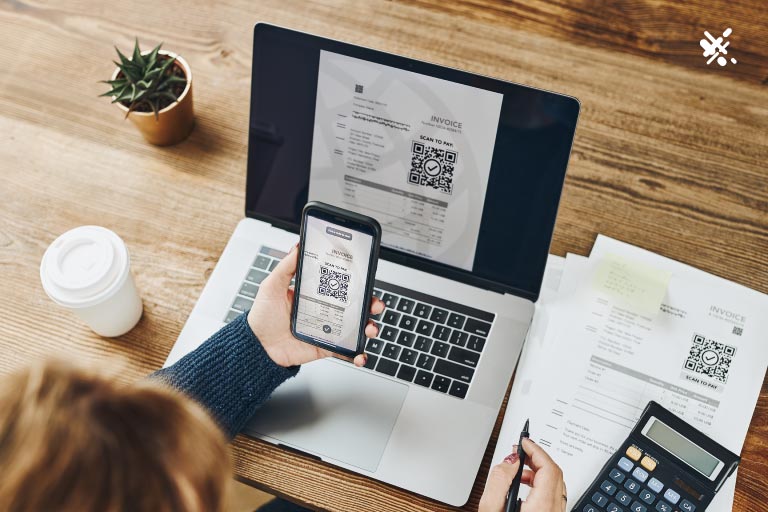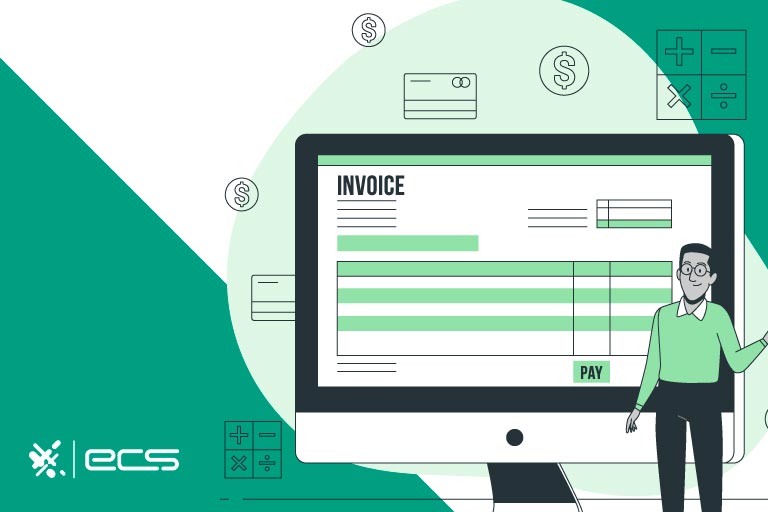Let’s talk about business and ultimately sales invoices. That’s right, I’m here to impart some of my hard-earned wisdom about collecting your money.
Once upon a time, I was like those merchants who fill out paper sales invoices for their goods and services. Even for a recurring invoice, I’d still do the same thing. At a certain point, I even hired a third party to manage my accounts receivable.
Things worked out for a while. But their services rendered did not include an accounting system that dealt with reconciliation. I was left reconciling invoice processing with my cash flow, which was still very time-consuming. Finally, I found the Holy Grail of vendor invoice management: my payment processor.
Retail: The Family Business
But before we talk business on the back end, let’s talk about the business of baseball.
My parents came to New York City from Puerto Rico in the late 1970s. My father owned a small newsstand in Manhattan, which was (and is) some prime real estate. His buddies helped him get set up in the business, and sometimes they would give him merch they couldn’t sell.
One day, he puts these “I love New York” bumper stickers by the register. With his business a few blocks from Chinatown, he would get a lot of tourists who wanted a magazine, some film, or a map.
People used film rolls and read maps in those days, I’m sure you know. Anyway, in one day he totally sold out of the stickers. This was before the “I love New York” slogan became so recognized. Tourists thought it was cute and wanted to take a sticker home.
That gave him an idea: why not start selling more touristy merchandise? He started trying out different items—hats, magnets, shirts. A star was born.
Going Big With New York-themed Merch
In about three years, he upgraded from a newsstand to a storefront. One became two. Two became three. Three became a satellite at the airport. You know, for last-minute gifts.
To be honest, I never talked to my father much about how he ran his business, or how he did his invoice accounting. But I learned a lot though about running a business on the front end.
However, it was not a business I’d end up inheriting. In 1995, he sold the business, and he and my mom moved to Miami. But all those years, growing up with his business, kind of put shop-keeping in my blood.
My Big Break
Now on to how I got started. I was in Queens College, working on an accounting degree. I figured I’d go into the corporate world. My parents thought that was the best thing for a second-generation Borinqueño.
Like everybody else, I wanted some extra spending money. Who doesn’t? My parents had closed up shop for about five years already, so no dice there. The Yankees were hot that year, so that gave me an idea. Why not take a page out of my father’s book and sell some merch?
I called my dad up in Miami and asked him what he thought. He said to start with hats. He even got in touch with one of his contacts and paid for the merch himself.
So here I am in the Bronx, with 30 hats on the street, taking cash. Of course, I made sure my hats were 50% cheaper than the official merch. Don’t judge me—you’ll see where the story goes.

From Slinging Street Merch to MLB Vendor
I sold out before the second inning. Didn’t even need to stick around until after the game. I called my father to tell him the news. He was excited about it. I think it made him think of the old days when he first got started. So he put me in touch with his buddy directly, and the three of us worked out a deal to get me more hats, shirts, and some other stuff.
And that’s how it was. I worked on my accounting degree while on nights and weekends, I slung merch in the Bronx. Things went great for a few months. Then a cop happened to walk by. I had seen what happened to some other merchants, so I started scooping everything up.
“Hey, slow down buddy. I ain’t gonna arrest you,” he began. I stopped. “But you and I both know you can’t be selling that out here.” He told me all about getting a vendor’s license, and how the MLB didn’t like street vendors selling knock-off merch. A real friendly specimen of New York’s finest. We shook hands and discovered we even knew a few people in common.
I called my father up and his response was just—okay, so how do we make you official? Over the next few weeks, I got my ducks in a row. I didn’t even know I could contact the MLB and work out a deal as a vendor to sell Yankees gear.
It was all a little pricier to get started, and the location was a little different. I’d start out with a kiosk in Grand Central Station. I wasn’t sure how things would go, so far removed from the yard, but the Yankees were hot again this year. People coming in from out of town to watch a game got shirts. New Yorkers got hats on their way to connect to the Bronx.
From Vendor to Regional Supplier
Everybody was buying Yankees gear. The merch was flying off the shelf. Before long I was ready to go from a kiosk to a storefront. I had shirts, hats, snow globes, bobbleheads…you name it. And with all this merch flying off the shelves, I also had lots of invoice processing.
But I didn’t just have invoices to pay. I also had sales invoices to collect payment. That’s because within a few years, I was not only a vendor of MLB gear, but a supplier. When I realized how much I could scale my business by supplying merch, and not just vending it, I made the switch.
I still kept my store open, but now I was supplying merch to about a dozen vendors throughout the city. I was importing hats and shirts from textile factories, and other types of merchandise from manufacturers. Then I would distribute this merch from a warehouse on Long Island to the different MLB vendors I sold to.
Bring In the Invoices
This all meant that I had to collect payment for the purchase orders. But in the business world, payment works a lot differently than it does for consumers. While you can ask for cash on delivery, you’ll win a lot more friends if you give your customers some time to pay.
Net-30 is one of the most common arrangements, giving the customer 30 days to pay. But you’ve got to keep track of this on paper, which is where processing an invoice comes into play.
Invoice Definition
An s document that includes key information from a sales order. This includes how much, the cost per unit, and the total cost. It includes information about the buyer and their location, and the seller and their location. And it includes payment terms, and how to pay.
Back in those days, we weren’t sending electronic invoices. And our customers were paying their invoices with a check. Pretty much everything was on paper. And guess what…if I didn’t get payment for invoices by the due date, that meant I would have to pick up the phone and make a call. Of course, to know who to call, I had to keep track of all the sales invoices to know the correct contact information.

Sales Invoices All Over My Office
You should’ve seen my office in those days. It looked like a detective’s joint. I even had one of those maps on the wall, with pins all around the city. Each pinhead was one of my locations. I didn’t have a bunch of strings leading to someone’s mugshot. But I would swap out green pinheads for red ones if I had a merchant in the red.
My desk was full of all types of invoices. I had unpaid sales invoices that hadn’t even been sent out yet. I had receipts from paid invoices I hadn’t reconciled with our cash flow and inventory. And I had a stack of receipts of paid invoices that were ready for my accountant to collect. It was all very organized, but only by a hairsbreadth. One foul ball and with everything knocked onto the floor, it could’ve taken half a day to reorganize.
By this point, I was no longer writing the sales invoices out myself. I had a company making the invoices for me. At the end of the month, they’d give me a sheet with invoice data on it. Each invoice number was there, the product categories and quantities, and the dollar amounts. I could also use this to reconcile everything with my business bank account.
The Pizza Party That Changed My Life
Don’t be surprised, but that foul ball ended up landing in my office. It’s a metaphor, really, because the foul ball was a stack of twenty pizza boxes. You see, it was another great year for the Yankees, and another great year for my business. We had reached a sales volume we had never seen before. And with the Yankees as hot as they were, this would mean more stores to supply merch to.
So I threw a party for everyone in the office. I ordered twenty pies of the best pizzas in the world. The party was going to begin in about thirty minutes, when I got an important phone call. A friend of mine was stuck at LaGuardia with no wallet and no money. He had left his billfold on the plane, but he needed to get home. Could I give him a ride?
I couldn’t say no, so I turned the office over to my warehouse manager and said I’d be back in about one hour. I come back to find the party has gotten off to a good start. People are drinking and eating and having a good time. I go back to the office, and what do I see…twenty pizza boxes piled high on my desk of invoices.
All of My Sales Invoices Were Soaked in Grease
The ones that weren’t all over the floor were soaked with oil. I couldn’t believe my eyes. Who did this? Turns out the warehouse manager was busy loading ice and beer into a kiddie pool. He had opened the warehouse door and shouted at the pizza delivery guy to put them on the first table he could find. I guess that turned out to be my office.
Nobody thought twice about the impact of five-cheese, meat-lover, and veggie-supreme on all my invoices. They were totally ruined. This was an accounting nightmare. I’d have to spend at least half a week piecing all this information back together again.
So I did what anybody else would do. I grabbed one slice of each topping, cracked open a cold one, and celebrated selling merch for the best team in baseball. I could figure out the invoicing thing mañana.
A Little Help From My Friends
Thankfully a solution presented itself pretty quickly. The next day I decided to cure my hangover with a little café and Pan de Mallorca. I saw one of my friends and business colleagues at the same cafe. He sells Mets gear, but I don’t hold it against him. We got to talking, and I told him about the invoice disaster.
To my surprise, he asked me why I was still sending paper invoices. Was I particularly attached to receiving checks? Did I like having hundreds of sales invoices to go through? Did I like having to keep track of who paid, and who didn’t? And how much was all that costing me?
Truth be told, each invoice was costing me about $10 per invoice, between the paper, printing, and accounting. I figured it was a small price to pay in return for collecting my money. But no, I didn’t really like anything else about it. I like receiving checks, but I’d be fine having the money show up in my account. If I could only figure out how to do that.

Why Don’t You Use Automated Sales Invoices?
My friend asked me about the one store I had at Grand Central. How did things work there? Were customers paying with checks? Of course not, I said. They were using credit cards. I had cash registers there with POS terminals, and they’d swipe their cards. There was significantly less paperwork in that department because so much of it was automated.
“So why not automate my invoice process?”, he asked me. Truth is, it hadn’t really occurred to me. Why fix something that ain’t broke? But obviously, something was broken with collecting my paper invoices. It was messy, it was time-consuming, and it was susceptible to mozzarella and sauce.
He explained to me that his payment processing company had set up a grand slam of invoice and bill processing. He didn’t take any checks from anybody anymore. All his vendors paid him with credit cards and debit cards. And all of his sales invoices were sent via email.
Sales Invoicing Means Nothing is On Paper
He also sent them a paper invoice for good measure. If they read the invoice online, they could click on a button that took them to an online payment portal. If they held the invoice in their hand, they could scan a QR code with their phone camera.
Then they would end up on the same page. There they could pay with a corporate card or an ACH transfer.
He told me all the benefits of doing things this way. For one, he didn’t have mountains of paper all over his desk. He laughed about the pizza thing, and I had to laugh too. If he wasn’t talking like a crazy benchwarmer in Central Park, I wouldn’t have to deal with paper any more anyway.
The other thing was that he got paid a lot faster. There was no waiting for invoices to get printed and sent. No waiting for the mailman to bring the invoice to the customer. Nor for the customer to twiddle their thumbs until they decided to mail a check. And there was no waiting for the check in the mail.
Email. Payment. Boom. Done. If they chose to ignore the invoice or they were honestly busy, they would get a paper one in the mail. With his cash flow sped up, he had more flexibility in managing his inventory.
Automated Sales Invoicing: Easy and Flexible
If the customer wanted a net-30 arrangement, the invoicing included that. They could choose to break the payment up into parts. They could also take advantage of 2/10 Net-30. In this type of arrangement, the customer has 10 days to pay the balance, and they get a 2% discount. Details like that are a nightmare to keep track of when you’ve got a dozen customers. But with automated invoices, it’s a breeze.
He saved the best for last. All of this invoicing was integrated with his accounting software. And his inventory management software. He didn’t need to spend hours at his desk, matching up sales invoices to bank statements and stamping them as PAID. I used to get a real workout from lifting my arm up and down for an hour or two, stamping PAID on those invoices. Well, now I wouldn’t have to do all that.

Can You Do This Sales Invoicing Stuff?
Between the quicker card payments, the paperless desk, and the integration with accounting and inventory, I was sold. He suggested I ask the payment processor I used for my one store if they did any of this. I was with Square back then. They’d been my payment processor for about five years.
They also had horrible customer service. I figured it was good to head to the mound before bringing in a new pitcher. So I called Square up and asked if they could do any of the things I was asking about. They said they could, so I asked for some pricing and said I’d sleep on it.
I brought the numbers to my Mets merch buddy the next day, over another café and pan. He took a quick look at the numbers and said I could do much better. Square might work for a small-time merchant selling things at low volume. But their flat-rate pricing would not work for a real business.
Time To Switch To A Different Payment Processor
This made me a little curious. Didn’t Square have a discount for more volume? Not really. Sure, they’d give you a little better flat rate if you sold more goods, but it was still a flat rate.
He explained to me about interchange-plus pricing. That each type of card, and each type of transaction, really had a different fee.
An interchange-plus pricing model would more accurately reflect the actual fees from the card networks. And then, of course, there was the matter of Square’s customer service. Don’t remind me! Square had been a nightmare to deal with over the phone. So much so, that paper invoices were even my preference.
My buddy gave me the name of his payment processor, which was ECS Payments. I called up the account manager he worked with. A nice fellow. We talked about business, and he asked some detailed questions about how it all worked. He explained to me how ECS could process all my payments—in-store and invoice payments—and how everything would be integrated with accounting and inventory.
I was sold. I didn’t even bother calling Square up. They don’t pick up the phone anyway. We swapped out the POS terminals in the store and set up an online payment portal. We set up the invoicing software and integrated it with the warehouse and my account’s software.
Electronic Sales Invoices Are the Way to Go
Fast forward to today. My desk is totally clean, except for pictures of the family. I love the feeling of a clean desk. I open up my computer, I check my invoices, and that’s it.
Everything is automated and integrated, so I can focus more on the things that matter. Like business. And family. And the Yankees.
This is the first year I might make it to every single home game. With the automated invoicing that integrates into my accounting and inventory, I can’t tell you how many more hours of free time I have.
I’m getting paid on time, I’m growing my business, and I’m able to focus on the things I love best. So if I could give you one piece of advice in closing, whatever type of business you run, it would be this: get those sales invoices automated. And go Yankees!
